As an Amazon Associate KitchenwareSets.com earns from qualifying purchases.
11 Warm Kitchen Aesthetic Ideas for Cozy Style on Any Budget
Is your kitchen the heart of your home, or does it feel more like a cold, sterile operating room? It’s a common problem, especially with the long-standing popularity of all-white or cool-grey kitchens. While beautiful and clean, they can sometimes lack the soul and comfort that makes a space truly feel like home, leaving you with a room that’s more functional than friendly.
You’ve probably scrolled through countless images on Pinterest, dreaming of those cozy, inviting kitchens that seem to wrap you in a warm hug. You want a space where family gathers, conversations flow, and memories are made. The challenge, however, is often the perceived cost and effort. The thought of a full-scale renovation is enough to make anyone stick with a kitchen they don’t truly love.
But here’s the secret: creating a warm kitchen aesthetic is achievable on any budget by focusing on layers of color, texture, and light. To make a kitchen feel warmer, you can introduce inviting color palettes on walls or cabinets, incorporate the natural texture of wood and woven fibers, and layer strategic lighting. Simple, affordable updates like adding a patterned rug, changing out cabinet hardware for a warm metallic, and displaying personal decor can completely transform a cold space into a cozy, stylish hub without a major renovation.
Dreaming of a Cozy Kitchen? Here’s How to Add Warmth Without a Full Renovation
To make a kitchen feel warmer, the most effective approach is to focus on introducing warm color palettes, natural textures like wood and woven fibers, and layered lighting. Simple updates such as adding a rug, changing cabinet hardware, and displaying personal decor can create a cozy, inviting atmosphere on any budget, transforming a sterile space into the true heart of the home.
Let’s be honest, a kitchen that feels cold or sterile just isn’t a place you want to linger. It becomes a purely utilitarian room for cooking and cleaning, rather than the vibrant, central hub of your home. You deserve a space that feels as good as the food you prepare in it. Drawing on years of interior styling and countless kitchen makeovers, we’ve distilled the most impactful changes that deliver warmth and character, proving you don’t need a massive budget to create your dream kitchen. This guide is your roadmap to transforming your kitchen from chilly to charming, using actionable, budget-friendly solutions that make a world of difference.
11 Warm Kitchen Aesthetic Ideas for Cozy Style on Any Budget (2025 Update)
Ready to turn up the temperature on your kitchen’s style? This curated list of 11 distinct, easy-to-follow strategies will guide you in creating a warm and inviting kitchen aesthetic. Each idea is packed with practical advice, budget-friendly alternatives, and pro-tips to ensure a successful and stylish outcome that you’ll love for years to come. These ideas are curated based on timeless design principles and the latest 2025 trends for creating inviting spaces, ensuring both longevity and freshness.
Whether you’re a renter looking for temporary solutions or a homeowner ready for a weekend project, these tips are designed to be both inspirational and incredibly achievable. Get ready to save these to your “Dream Kitchen” board!
1. Embrace Warm & Inviting Color Palettes
The quickest way to change the entire mood of your kitchen is with a fresh coat of warm-toned paint. Color is emotional, and choosing a hue with warm undertones—like beige, taupe, soft brown, or even a blush pink—instantly makes a space feel more welcoming and less stark. This is the foundation of the warm kitchen aesthetic.
Paint is a famously budget-friendly update with an incredibly high impact. You can choose to paint the walls, the cabinets, or even just an accent feature like the kitchen island or the ceiling. For kitchens that lack abundant natural light, it’s wise to stick with lighter shades like warm off-whites or soft greiges (a mix of grey and beige) to keep the space from feeling dingy. If you’re feeling bold, a deep emerald green or a rich ruby red can add a layer of sophistication and incredible warmth.
Actionable Content
- Materials Needed: High-quality interior paint (e.g., beige, taupe, soft brown, blush pink), painter’s tape, drop cloths, rollers with extension pole, angled brushes for cutting in, primer (if needed), cleaning supplies (degreaser).
- Step-by-Step Directions:
- Choose Your Hue: Select a warm color that complements your existing countertops and flooring. Grab a few sample pots to test on your walls.
- Prep Your Space: This is the most crucial step! Empty the room as much as possible. Thoroughly clean walls or cabinets with a degreaser to remove any grime. Protect floors and counters with drop cloths and carefully apply painter’s tape along trim, ceilings, and edges for sharp, professional lines.
- Prime if Necessary: If you are painting over a very dark color or painting unfinished wood cabinets, applying a quality primer is non-negotiable. It ensures better adhesion and true color. Let it dry completely according to the manufacturer’s instructions.
- Apply Paint: Use an angled brush to “cut in” along the edges and corners where a roller can’t reach. Then, use a roller to fill in the large surfaces, applying paint in a “W” pattern for even coverage. Allow the first coat to dry completely before applying a second for a rich, durable finish.
Pro-Tip: “Always test paint swatches on your wall and observe them at different times of the day. The way natural and artificial light hits the color can dramatically change its appearance. What looks like a perfect warm beige in the morning might look too yellow or green at night.”
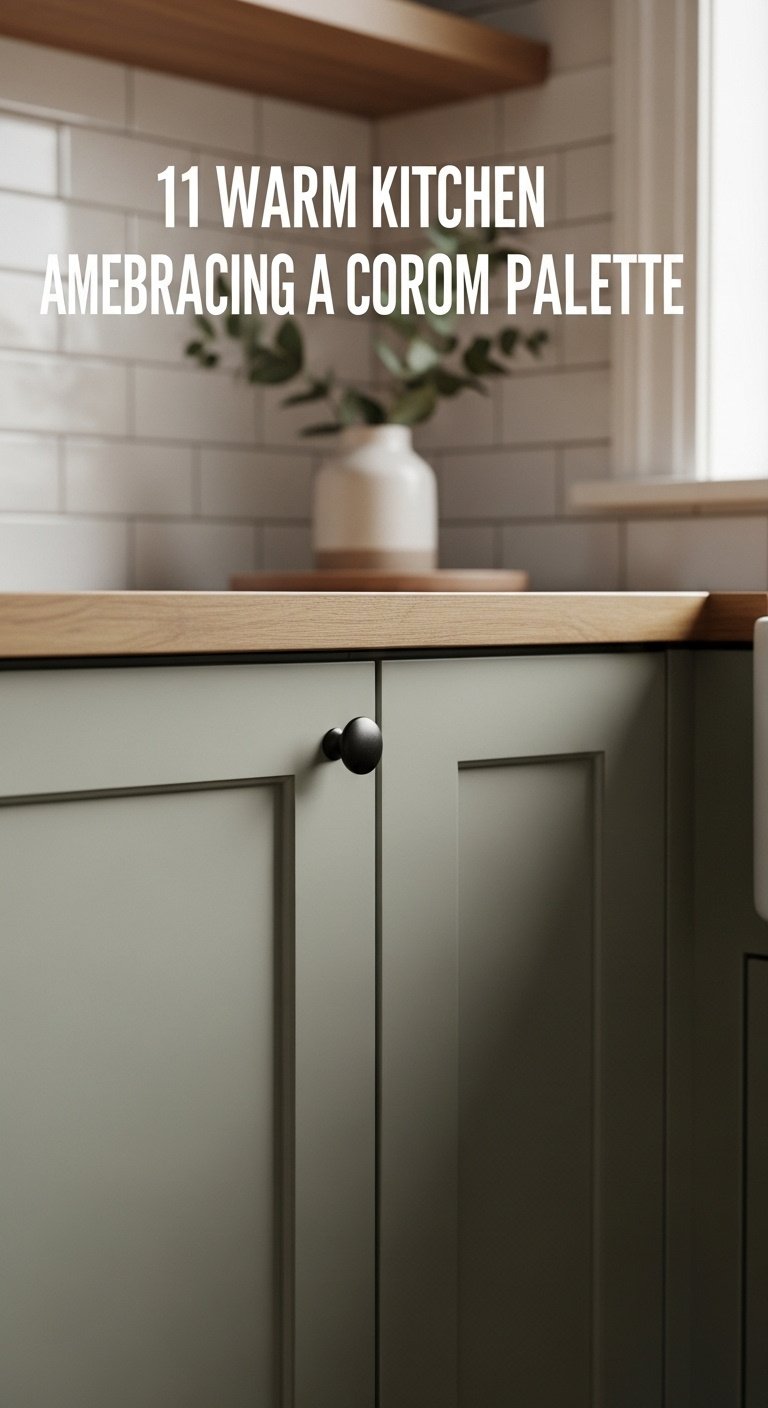
Pin this color inspiration for your next weekend project!
2. Incorporate Natural Wood Accents
Nothing says “warmth” quite like the natural texture and tone of wood. Wood has an inherent, organic quality that instantly grounds a space and makes it feel cozier. If you have honey-hued wood cabinets, consider working with them rather than against them. For those with painted cabinets, incorporating wood accents is the key to warming up the room.
You can introduce wood in many ways, both big and small. Larger-scale additions include butcher block countertops or installing open shelving. On a smaller, more budget-friendly scale, simply leaning a collection of vintage wooden cutting boards against your backsplash, using a wood knife block, or displaying wooden salad bowls can have a surprisingly large impact.
Actionable Content
- Materials Needed: Floating wood shelves, heavy-duty brackets, a level, a power drill, a stud finder, wooden cutting boards of various sizes, decorative wood bowls or utensil holders.
- Step-by-Step Directions:
- Choose Your Accent: Decide on the scale of your project. Start small by curating a collection of wooden kitchen tools and displaying them in a ceramic crock. For a bigger statement, plan to install one or two floating shelves.
- Install Shelving (DIY): Use a stud finder to locate the secure mounting points in your wall—this is essential for ensuring the shelves can hold the weight of your dishes. Use a level to mark a straight line for your brackets. Drill pilot holes, then firmly secure the brackets to the wall studs. Place your wooden shelf on top and fasten it to the brackets from below.
- Style Your Wood: The key is to create a collected, not cluttered, look. Group items like cutting boards and bowls together. Lean larger boards against the wall and place smaller items in front to create depth.
Lesson Learned: “Don’t feel like all your wood tones have to match perfectly. In my experience, mixing different woods, like a light oak shelf with a darker walnut cutting board, adds incredible depth and character. It creates a more authentic, collected-over-time feel that is central to a warm kitchen aesthetic.”
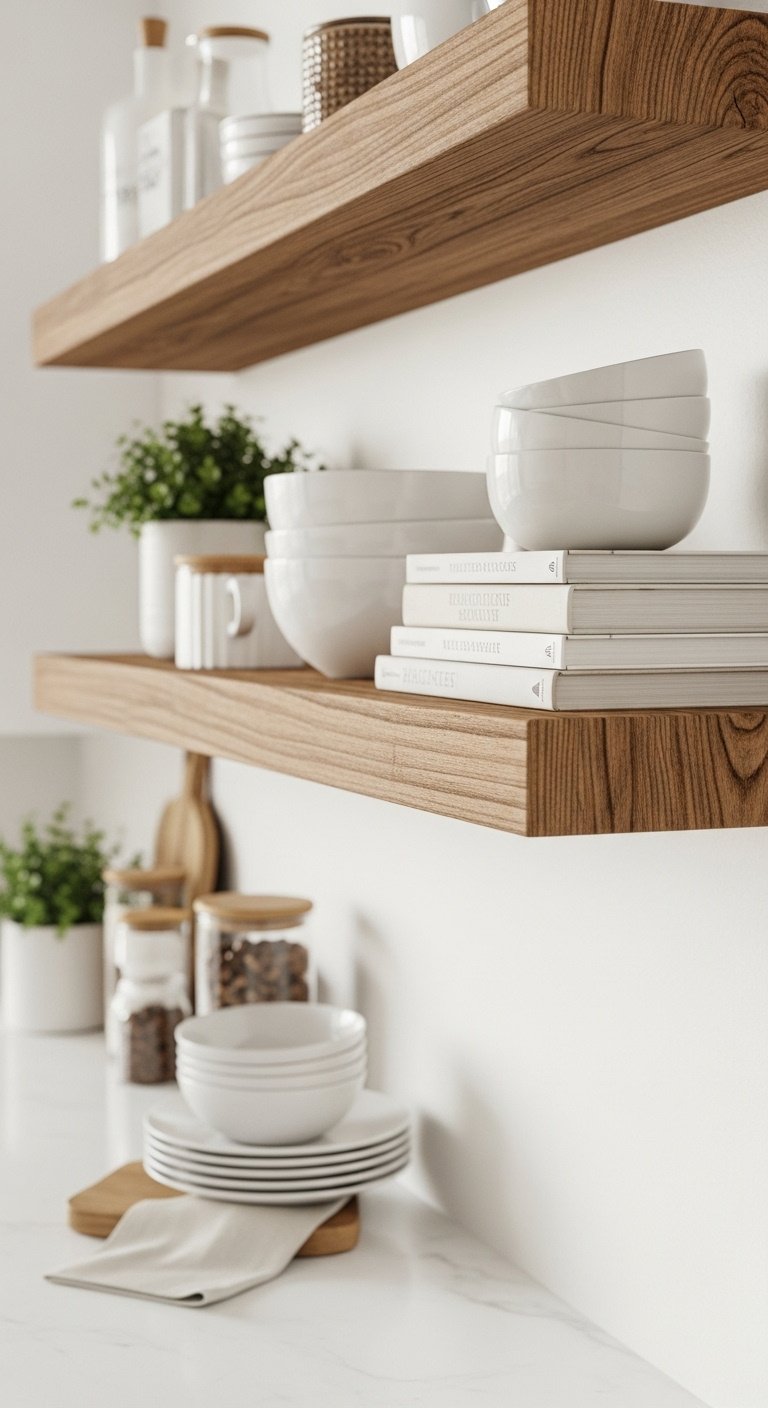
Love this look? Save it to your ‘Dream Kitchen’ Pinterest board!
3. Utilize Strategic & Warm Lighting
The right lighting can completely change the mood of a kitchen from a clinical workspace to a cozy gathering spot. Most kitchens are fitted with harsh, overhead fluorescent or cool-toned LED lighting that can make everything feel sterile. The secret to a warm ambiance is layering different types of light and ensuring the light itself has a warm quality.
Think of your lighting in three layers: ambient (the main overhead light), task (focused light for workspaces, like under-cabinet lighting), and accent (mood lighting, like a beautiful pendant). Swapping out a generic ceiling fixture for a statement pendant light made from natural materials like rattan or woven fabric can add both warmth and texture.
Actionable Content
- Materials Needed: Peel-and-stick LED under-cabinet light strips, a statement pendant light fixture, a dimmer switch compatible with your lights.
- Step-by-Step Directions:
- Add Task Lighting: For a quick, high-impact, and renter-friendly update, install battery-operated or peel-and-stick LED strips under your upper cabinets. Simply clean the surface thoroughly, peel the adhesive backing, and press the strip firmly into place. This instantly brightens your countertops and creates a warm glow.
- Install a Statement Pendant: Over a kitchen island or sink, swapping a basic builder-grade fixture for a stylish pendant can serve as a stunning focal point. While hardwiring is best left to an electrician, there are also plug-in pendant options available.
- Install a Dimmer: This is a non-negotiable for creating ambiance. Replace your main light switch with a dimmer switch. This allows you to have bright, functional light when you’re cooking and a soft, inviting glow for dinner or evening conversations.
Pro-Tip: “Pay close attention to the color temperature of your light bulbs. This is a game-changer. Look for bulbs labeled ‘warm white’ or those with a rating around 2700K to 3000K. This will cast a cozy, yellowish, inviting glow rather than a harsh, blue-toned light that feels like an office.”
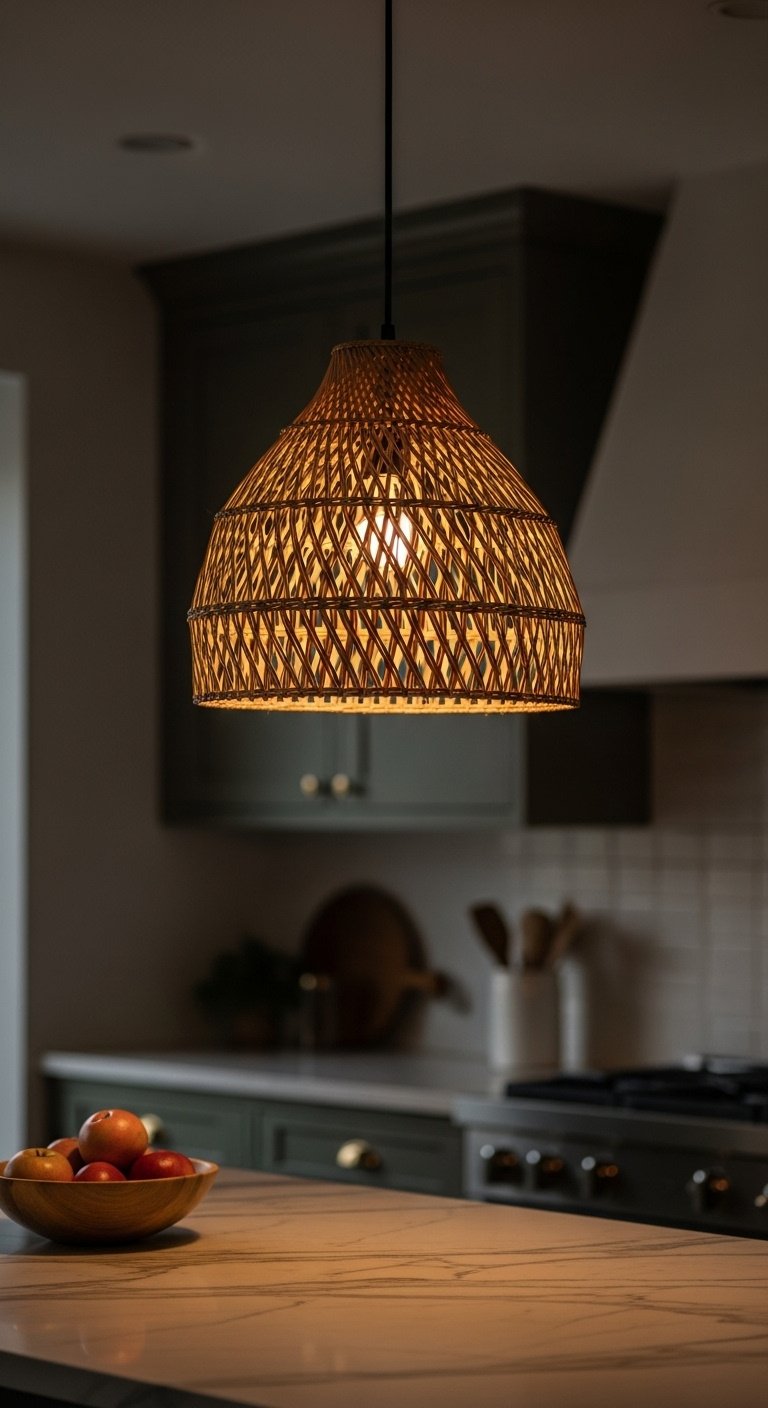
Light up your life! Pin this cozy lighting idea.
4. Add a Textured Backsplash
A backsplash is a prime opportunity to inject personality, color, and crucial texture into your kitchen. Moving beyond simple, flat subway tiles to something with more character can make a huge difference. Materials like hand-finished terracotta or zellige tiles offer subtle imperfections and variations in color that catch the light beautifully and add a layer of rustic warmth.
Don’t have the budget or time for a full tile job? No problem. The market for high-quality peel-and-stick backsplashes has exploded. You can find incredibly realistic options that mimic everything from patterned tiles to textured shiplap, offering a budget-friendly and renter-friendly way to achieve a warm, custom look.
Actionable Content
- Materials Needed: High-quality peel-and-stick tile sheets, a measuring tape, a utility knife or sharp scissors, a level, a smoothing tool (or credit card).
- Step-by-Step Directions:
- Measure and Clean: Carefully measure the height and width of your backsplash area to calculate how many tile sheets you’ll need. The wall surface must be perfectly clean and dry, so wipe it down with a degreasing cleaner and allow it to dry for several hours.
- Plan Your Layout: Start from a prominent outer corner. Use a level to draw a faint pencil guideline on the wall to ensure your first row of tiles goes on perfectly straight.
- Peel and Stick: Carefully peel back the first few inches of the backing from a tile sheet. Align the edge with your guideline and press it firmly onto the wall, slowly peeling off the rest of the backing as you smooth the tile down to prevent air bubbles.
- Overlap and Cut: Modern peel-and-stick tiles are designed to overlap seamlessly. Align the next sheet over the designated grout lines of the first. When you reach an outlet or corner, hold the tile in place and mark where you need to cut, then use a utility knife for a precise trim.
Lesson Learned: “For peel-and-stick tiles, I always recommend buying about 10% more than your measurements call for. Having extra on hand to account for mistakes, mis-cuts, or tricky angles is a total lifesaver and ensures you get a professional-looking finish without a last-minute panic.”
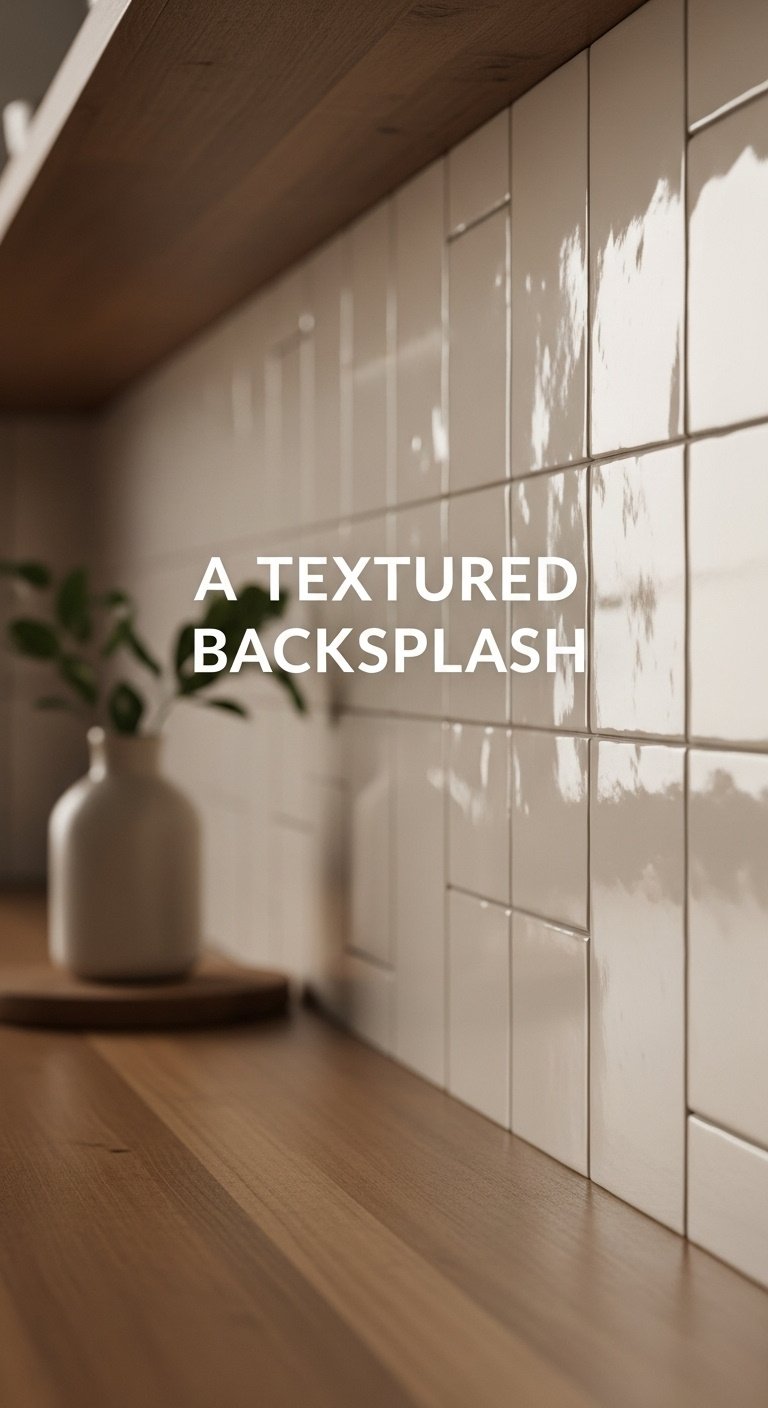
Transform your kitchen this weekend! Save this easy backsplash idea.
5. Display Decorative & Functional Items
An easy way to make a kitchen feel warm and lived-in is to display a curated collection of your favorite dishware and functional tools. Open shelving provides the perfect stage for this, turning everyday items into a design statement. This approach adds personality and tells a story, making the kitchen uniquely yours.
Instead of hiding everything away, select items that are both beautiful and useful. Think stoneware mugs, stacks of ceramic bowls, beautiful cookbooks, and even functional items like copper pans or a collection of wooden spoons in a crock. This not only adds visual interest but also makes the space feel more accessible and user-friendly.
Actionable Content
- Materials Needed: Your favorite dishware (mugs, bowls, plates), wooden cutting boards, copper pans, a collection of cookbooks, small potted plants or fresh herbs, decorative plates, art.
- Step-by-Step Directions:
- Curate Your Collection: Be selective. Choose items you genuinely love and use often. Stick to a cohesive color palette to avoid a chaotic look—think earthy neutrals, calming blues, or simple whites and creams.
- Layer for Depth: When styling shelves, start by placing larger, flatter items like cutting boards, platters, or a framed piece of art at the very back to create a backdrop.
- Vary Height and Texture: Create visual interest by mixing the height and shape of objects. Stand some cookbooks upright and use others, laid flat, as a riser for a small bowl. Incorporate different textures like smooth ceramic, rough wood, and shiny metal.
- Add Life: The final touch is always a bit of green. A small potted plant, a trailing vine like a pothos, or a simple vase of fresh herbs will bring vitality and freshness to your shelves.
Pro-Tip: “When styling, I always follow the ‘rule of three.’ Grouping items in odd numbers, especially threes and fives, is inherently more visually appealing and dynamic to the human eye than even-numbered groupings. Try arranging a small vase, a stack of two bowls, and a small plant together.”
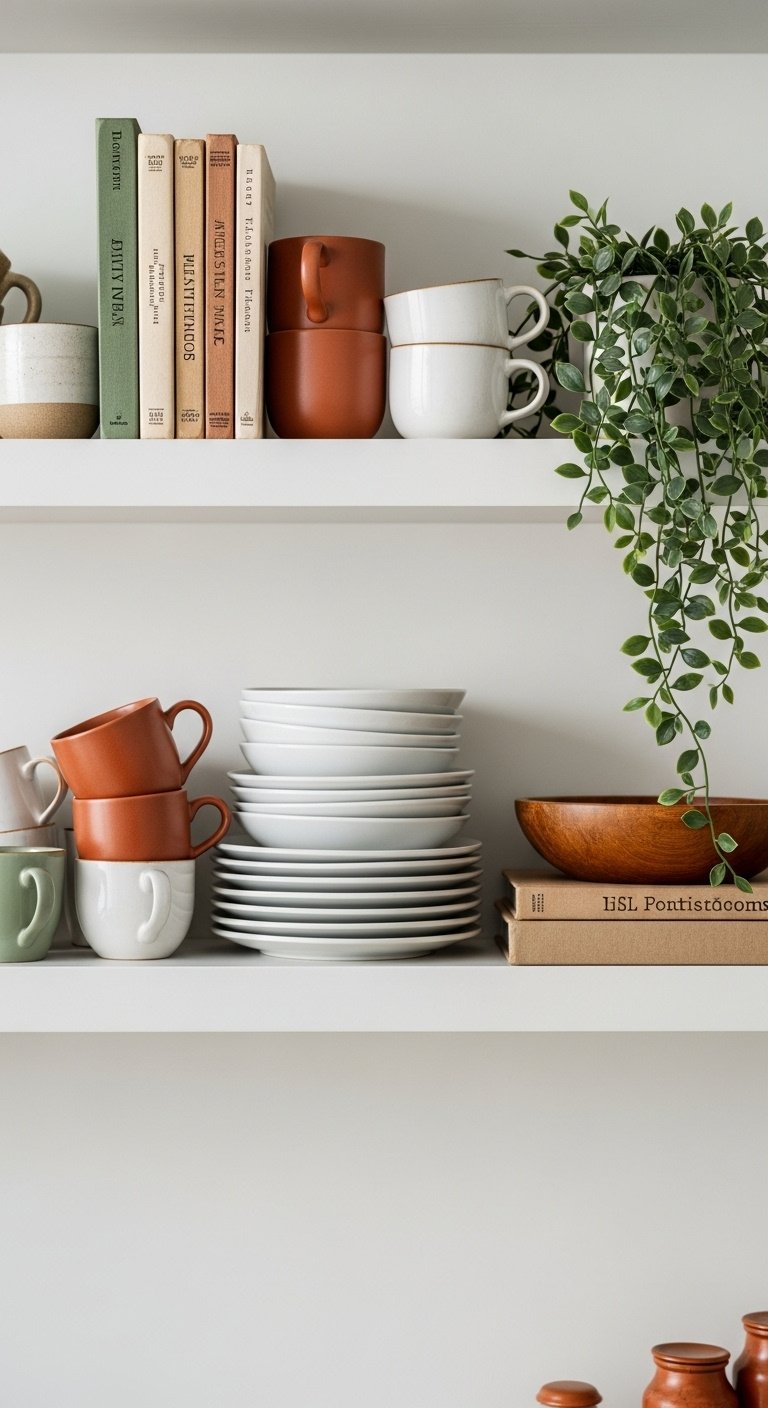
Get the curated look! Pin these shelf styling tips.
6. Introduce Soft Textiles
Kitchens are full of hard surfaces—stone, metal, wood, and tile. The key to counteracting this is to introduce soft textiles to add physical and visual warmth. A simple rug or a pair of curtains can instantly make a kitchen feel softer, quieter, and more comfortable.
A colorful or patterned kitchen runner is one of the most effective ways to add an injection of warmth, color, and texture. It also provides a soft, comfortable surface to stand on while cooking or washing dishes. Beyond the floor, simple fabric touches like gingham or linen cafe curtains, or even just a beautifully patterned tea towel draped over the oven handle, contribute to a cozy, personalized feel.
Actionable Content
- Materials Needed: A durable kitchen runner or rug (washable is highly recommended), a tension rod, a pair of cafe curtains, decorative tea towels.
- Step-by-Step Directions:
- Add a Runner: Choose a runner rug in a warm color palette or an engaging pattern. Place it in the main walkway of your kitchen, typically in front of the sink and main prep area, to add instant softness, absorb sound, and provide comfort underfoot.
- Hang Curtains: For a soft, cottagecore or farmhouse feel, hang simple cafe curtains. These are incredibly easy to install using a tension rod that fits inside your window frame—no drilling required! A simple gingham, striped, or floral pattern works wonders.
- Display Pretty Towels: Don’t hide your best tea towels in a drawer. Treat them as decor. Drape a colorful or beautifully patterned towel over your oven or dishwasher handle for a small but mighty touch of warmth and personality.
Lesson Learned: “When choosing a kitchen rug, my best advice is to always opt for a flatweave or low-pile material, and if possible, one that is machine washable. From personal experience, a washable rug is an absolute game-changer for a high-traffic, high-spill area like the kitchen. It makes life so much easier!”
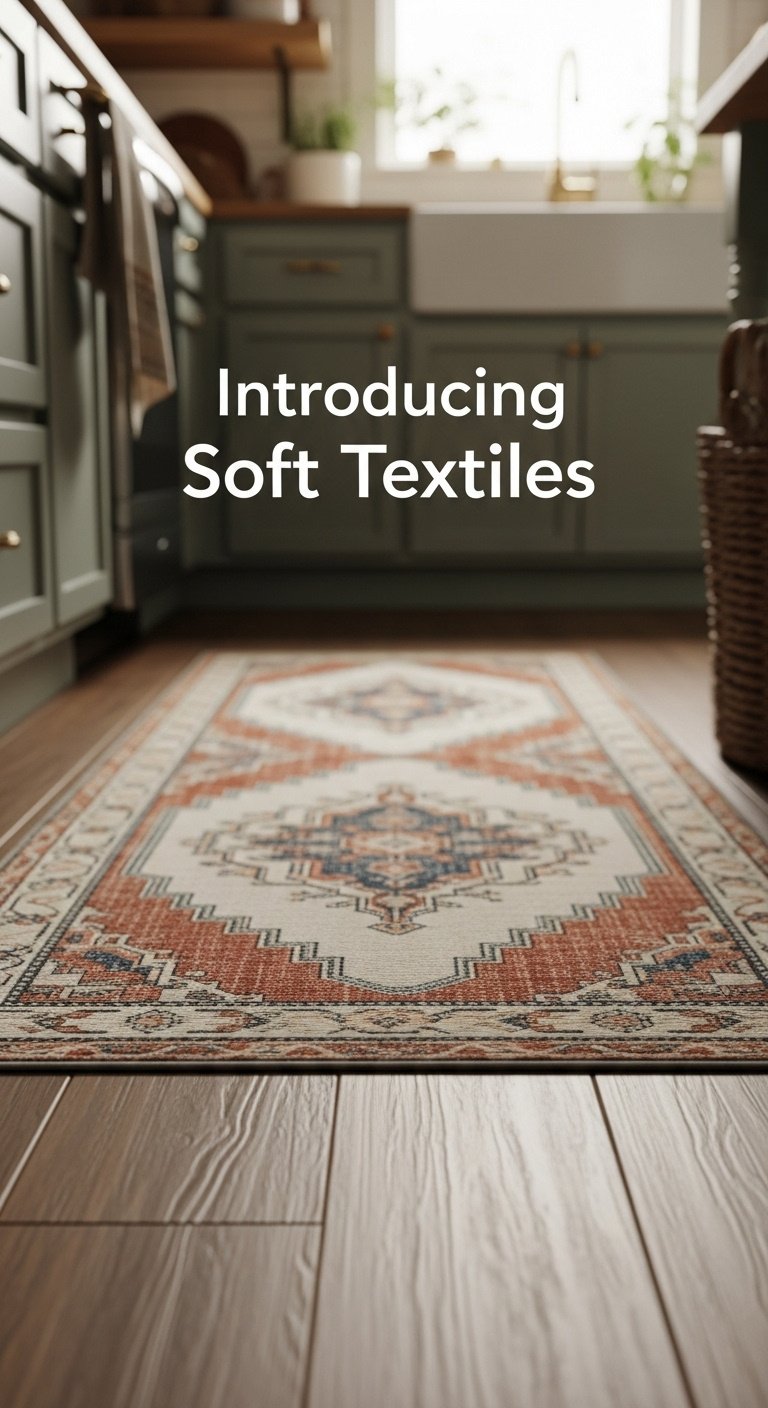
Cozy up your kitchen! Save this textile idea to your home decor board.
7. Update Outdated Hardware
One of the most affordable and transformative DIY projects is to swap out old, dated cabinet knobs and pulls for new ones. This small change can have a significant impact on the overall look and feel of your kitchen, instantly modernizing the space and tying into your warm aesthetic.
Finishes like standard polished chrome can sometimes feel cold. By switching to hardware in a warmer finish, you add an immediate touch of warmth and elegance. Matte black provides a modern, grounding contrast, while finishes like brushed brass, antique gold, or warm copper introduce a metallic glow that complements warm tones beautifully.
Actionable Content
- Materials Needed: New cabinet knobs or pulls, a screwdriver, a measuring tape (if you’re switching from knobs to pulls or changing pull sizes).
- Step-by-Step Directions:
- Measure First: This is critical! If you are replacing pulls with new pulls, you must measure the distance between the center of the two screw holes on your existing hardware. This is your “center-to-center” measurement. Buying new pulls with the same measurement will save you from having to drill new holes. Swapping knobs is a simple one-for-one replacement.
- Unscrew the Old: Open your cabinet door or drawer. Use a screwdriver to remove the screw from the inside that is holding the old hardware in place.
- Screw in the New: Position your new knob or pull over the existing hole(s) from the outside, and then secure it by tightening the new screw from the inside. It’s usually a five-minute job per cabinet!
Pro-Tip: “Think of hardware as the jewelry for your cabinets. It’s the finishing touch that pulls the whole look together. A warm metallic like brushed brass or copper can instantly make even simple white or wood cabinets feel more luxurious, custom, and inviting.”
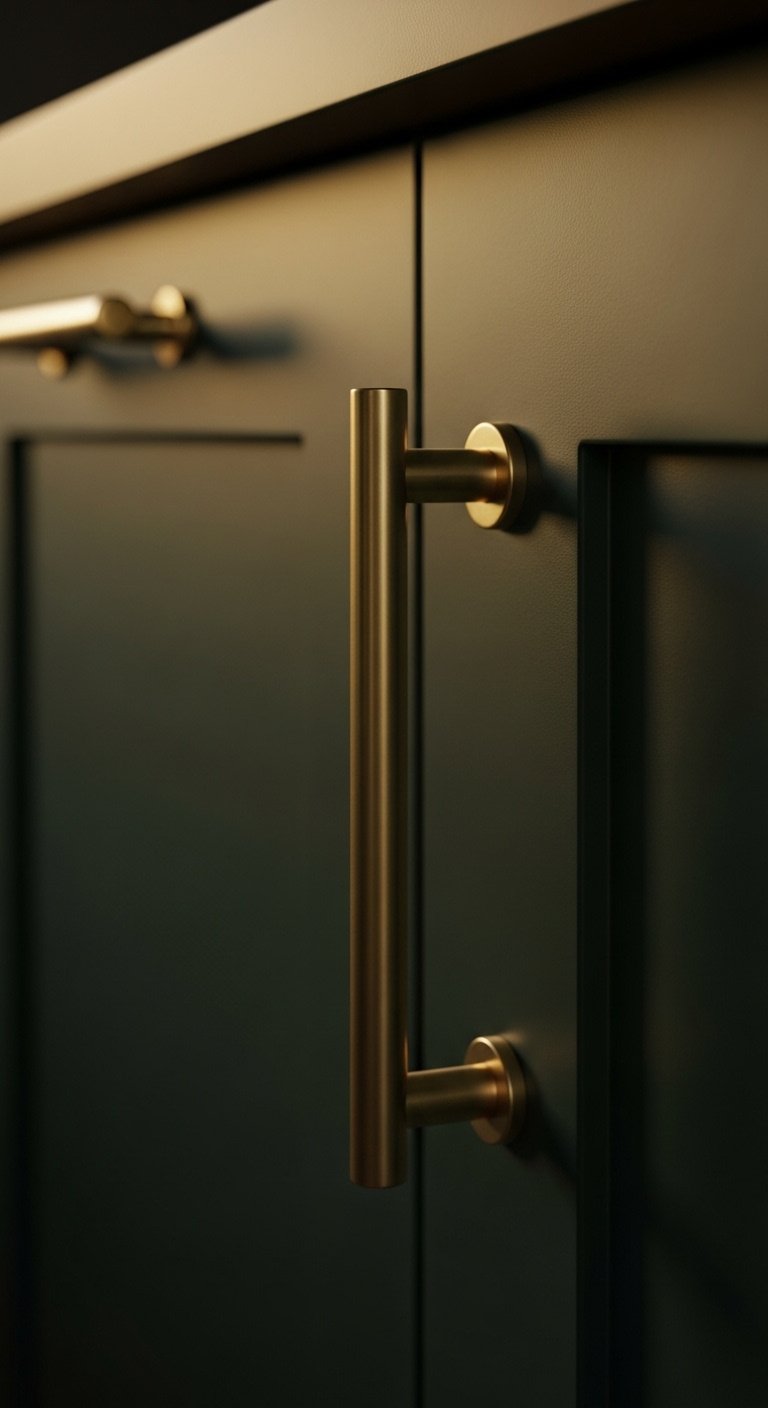
The easiest kitchen update ever! Pin this hardware idea.
8. Bring in Greenery & Life
To prevent a warm, neutral kitchen from feeling flat, it’s essential to add touches of life and freshness with indoor plants. Greenery adds a vibrant, organic element that contributes to a calming and vital environment. Plants are a simple and affordable way to add natural color and texture.
You don’t need to turn your kitchen into a jungle. A few well-placed plants are all it takes. A small collection of potted herbs on a windowsill is both beautiful and functional for cooking. A trailing plant like a pothos or philodendron placed on top of a cabinet or a high shelf can add a lovely draping effect.
Actionable Content
- Materials Needed: Small potted plants (herbs like basil, mint, or rosemary are great choices), decorative pots that match your aesthetic (terracotta, ceramic, woven baskets), a macrame plant hanger, and a ceiling hook.
- Step-by-Step Directions:
- Start on the Sill: A sunny windowsill is the perfect home for a small collection of sun-loving herbs in classic terracotta pots. They add instant life and are wonderfully functional for snipping into your meals.
- Go Vertical: If your counter space is precious, think upwards! Place an easy-care trailing plant on top of your refrigerator or upper cabinets and let its vines cascade down.
- Hang it Up: For a boho-chic touch, use a simple macrame plant hanger and a secure ceiling hook to suspend a plant in an empty corner. This adds a beautiful touch of green without taking up any surface area at all.
Lesson Learned: “Don’t have a green thumb? Don’t worry! Start with hard-to-kill plants. In my own kitchen, I rely on a snake plant and a ZZ plant. They are incredibly forgiving, tolerate lower light conditions and infrequent watering, making them the perfect, low-stress green companions for a busy kitchen.”
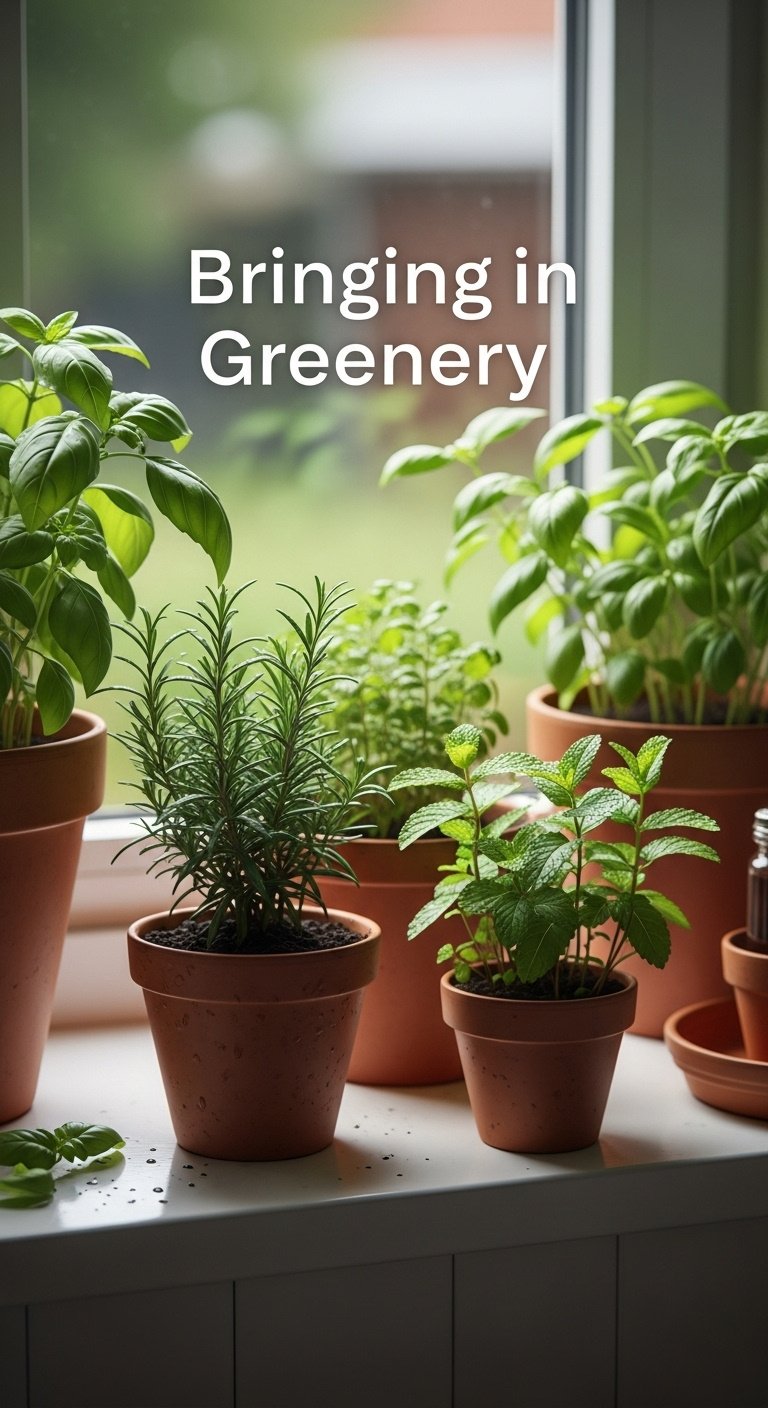
Add some life to your kitchen! Save this plant styling tip.
9. Consider Warm Butcher-Block Countertops
For a truly warm and natural look, butcher-block countertops are a fantastic and often budget-friendly choice. Compared to many cold stone options like granite or marble, wood countertops offer an unmatched warmth and add incredible character to a cozy kitchen aesthetic. They are particularly at home in farmhouse, traditional, and rustic modern designs.
While they do require a bit more maintenance than stone, they are also more forgiving. They are naturally antibacterial and hold up well to daily use. One of the best features is that, unlike a chipped stone counter, minor scratches or stains on a butcher block can be easily sanded out and the surface re-oiled to look brand new.
Actionable Content
- Materials Needed: A butcher block slab (available at most home improvement stores), food-safe mineral oil or a specialized wood conditioner, soft, lint-free cloths.
- Step-by-Step Directions:
- Installation: While a full countertop installation is a larger project, you can easily incorporate butcher block on a smaller scale. Consider using it just for your kitchen island or for a small, dedicated baking station to add a warm, functional accent.
- Sealing is Key: To protect the beautiful wood from stains and water damage, it must be properly sealed. For a food-safe finish that allows you to chop directly on the surface, you’ll need to use food-grade mineral oil.
- Application: The process is simple but requires repetition. Pour a generous amount of oil onto the surface and spread it evenly with a soft cloth, ensuring you cover every inch. Let the oil soak in for at least 30 minutes (or overnight for the first coat), then wipe away any excess.
- Maintenance: To keep your countertops looking their best and to maintain their protective barrier, you’ll need to re-oil them regularly—about once a month is a good rule of thumb.
Pro-Tip: “Butcher block will inevitably show some wear and tear over time—knife marks, small dings—but that’s a huge part of its charm! It develops a beautiful patina that tells the story of the meals made in your kitchen. You can easily sand out any major scratches and re-oil the surface to refresh it, a benefit you simply don’t get with stone.”
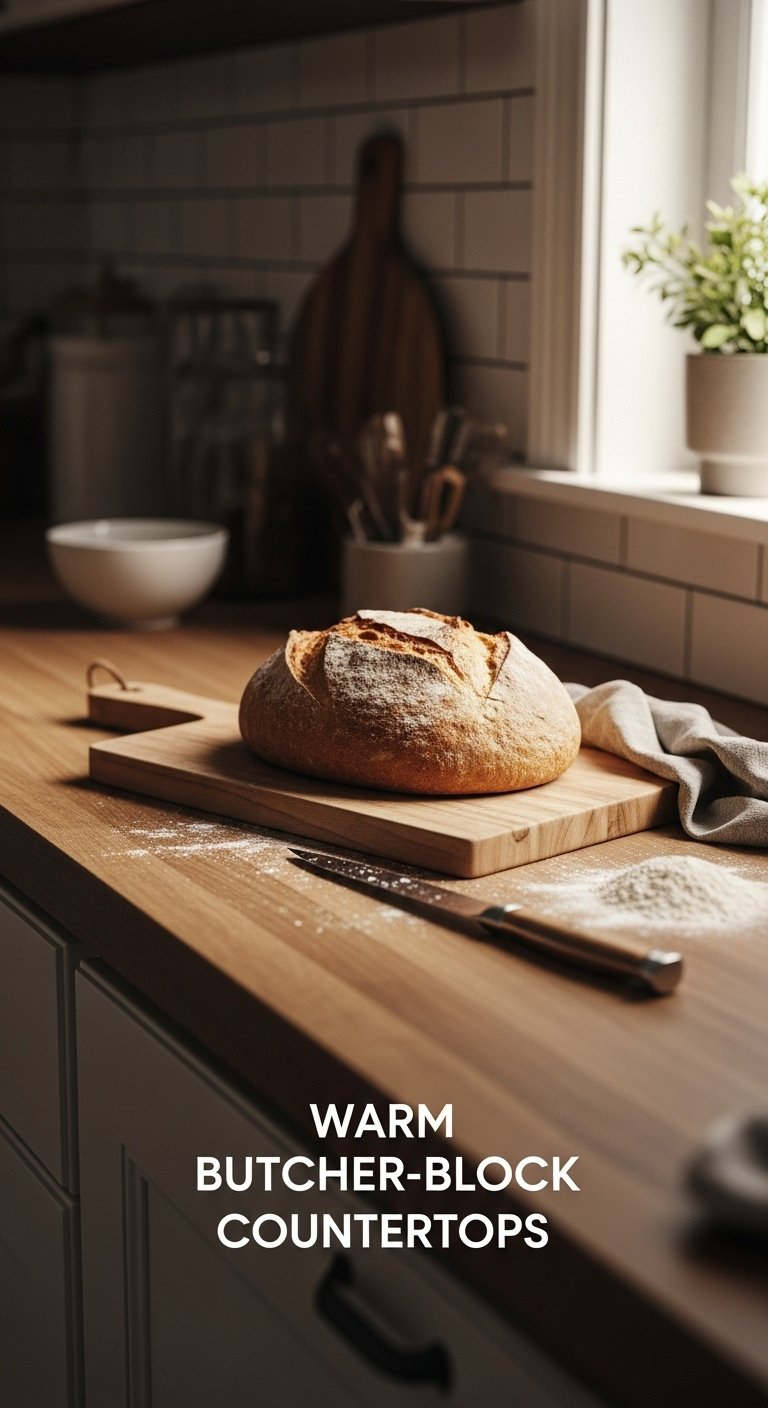
Dreaming of wood countertops? Pin this for inspiration!
10. Incorporate Warm Metallic Accents
Adding touches of warm metals is like adding jewelry to your kitchen; it provides a touch of luxury and helps bounce light around the room, making it feel brighter and more inviting. Metals like brass, copper, and antique gold have warm, reflective qualities that can instantly elevate a simple space.
You can incorporate these metals through hardware, as we’ve discussed, but also through light fixtures, faucets, or even displayed cookware and accessories. A gleaming copper kettle on the stovetop, a set of brass canisters for coffee and tea, or a beautiful gold-toned faucet can all serve as warm, sparkling focal points.
Actionable Content
- Materials Needed: Brass or copper kitchen canisters, a copper kettle, brass salt and pepper grinders, a high-quality brass or copper spray paint for small DIY projects.
- Step-by-Step Directions:
- Start Small with Accents: You don’t need to replace all your fixtures at once. Start by introducing one or two key pieces. Displaying a beautiful copper kettle on your stovetop or placing a set of brass canisters on the counter is an easy, non-permanent way to try out the look.
- Unify with Hardware: As mentioned in tip #7, swapping out your cabinet hardware for a warm metallic is one of the most powerful ways to introduce a consistent, high-end theme.
- DIY a Metallic Accent: For a super budget-friendly touch, find a simple ceramic vase, a picture frame, or a tray at a thrift store. Use a high-quality metallic spray paint (designed for the item’s material) to transform it into a luxe-looking piece to display on a shelf.
Lesson Learned: “From my own design projects, I’ve learned that a little goes a long way. The key is consistency, not quantity. Choose one dominant warm metal, like brass, and use it in 3-4 key places around the kitchen (e.g., cabinet hardware, faucet, light fixture). This creates a cohesive, intentional, and high-end look without being overwhelming or tacky.”
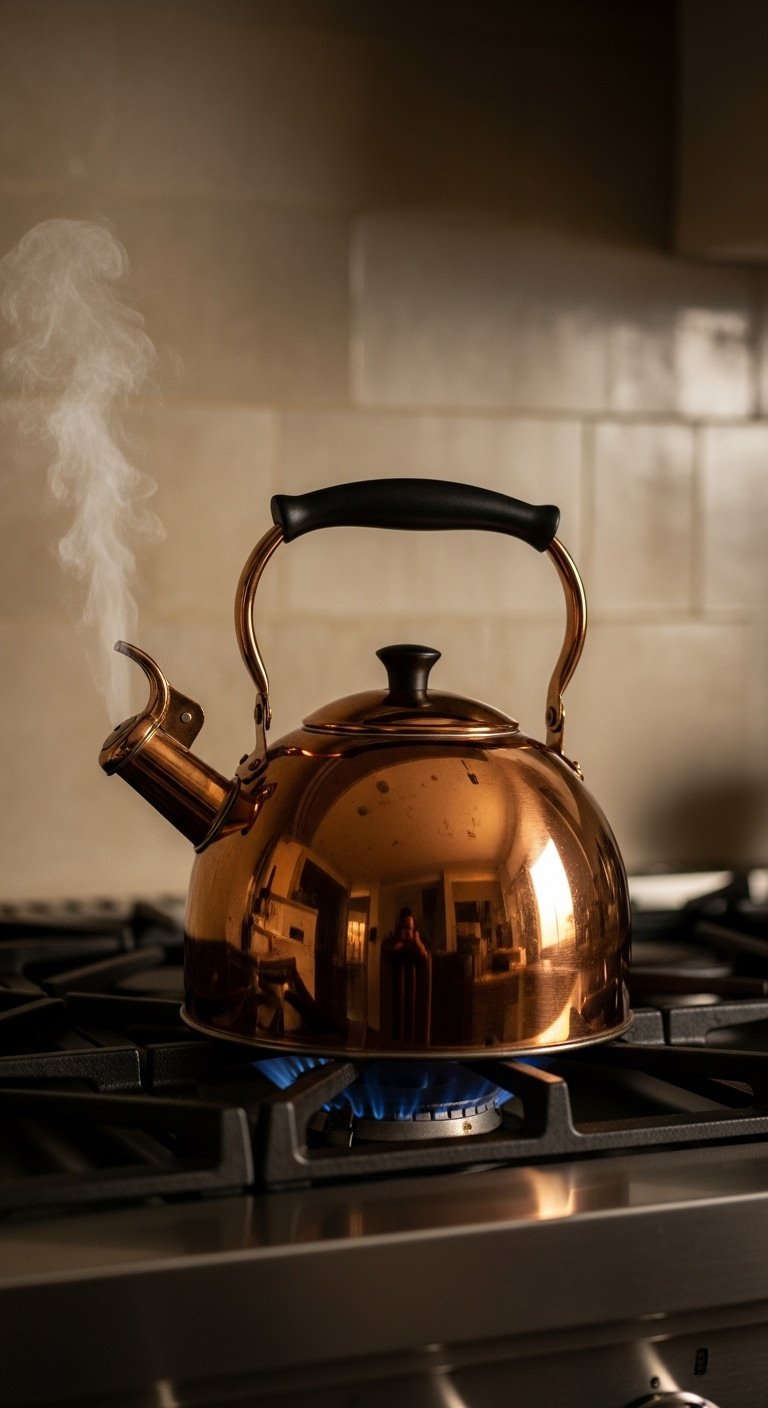
Add a touch of glam! Save this metallic accent idea.
11. Maximize Small Spaces with Cozy Nooks
Even the smallest kitchen can feel warm and inviting. The key is to use multi-functional pieces to create cozy, defined zones, like a small dining nook. Carving out a dedicated space for sitting, even if it’s just for one or two people, instantly adds a layer of warmth and charm and encourages people to linger.
For smaller kitchens, a portable kitchen island on wheels can add both a warm wood work surface and extra storage without the commitment of a built-in. A built-in banquette, or even just a simple storage bench placed against a wall with a small table, can create a cozy dining nook that maximizes seating and adds immense charm.
Actionable Content
- Materials Needed: A small bistro table and two chairs OR a pre-made storage bench, several comfortable pillows or a custom cushion, and a small pendant light (plug-in style for ease).
- Step-by-Step Directions:
- Identify a Nook: Look for any unused corner or a small, empty section of a wall in or near your kitchen. This will be the home for your cozy nook.
- Create a Banquette: The easiest way to do this is to place a simple storage bench against the wall. This provides both seating and valuable hidden storage for things like lesser-used appliances or seasonal linens. Pair it with a small, round table and one or two chairs on the other side.
- Add Comfort and Style: Layer the bench with comfortable cushions and decorative pillows in warm textures and colors that tie into your overall kitchen aesthetic.
- Define the Space: To make the nook feel intentional and separate, hang a small pendant light directly over the table. A plug-in “swag” light is a great renter-friendly option that doesn’t require an electrician. This defines the nook and creates an intimate, cozy spot for morning coffee or a casual meal.
Pro-Tip: “In my experience designing for small spaces, a round or oval table is almost always better for a cozy nook than a square one. It has a smaller physical and visual footprint, and the lack of sharp corners makes it much easier to navigate around in a tight space.”
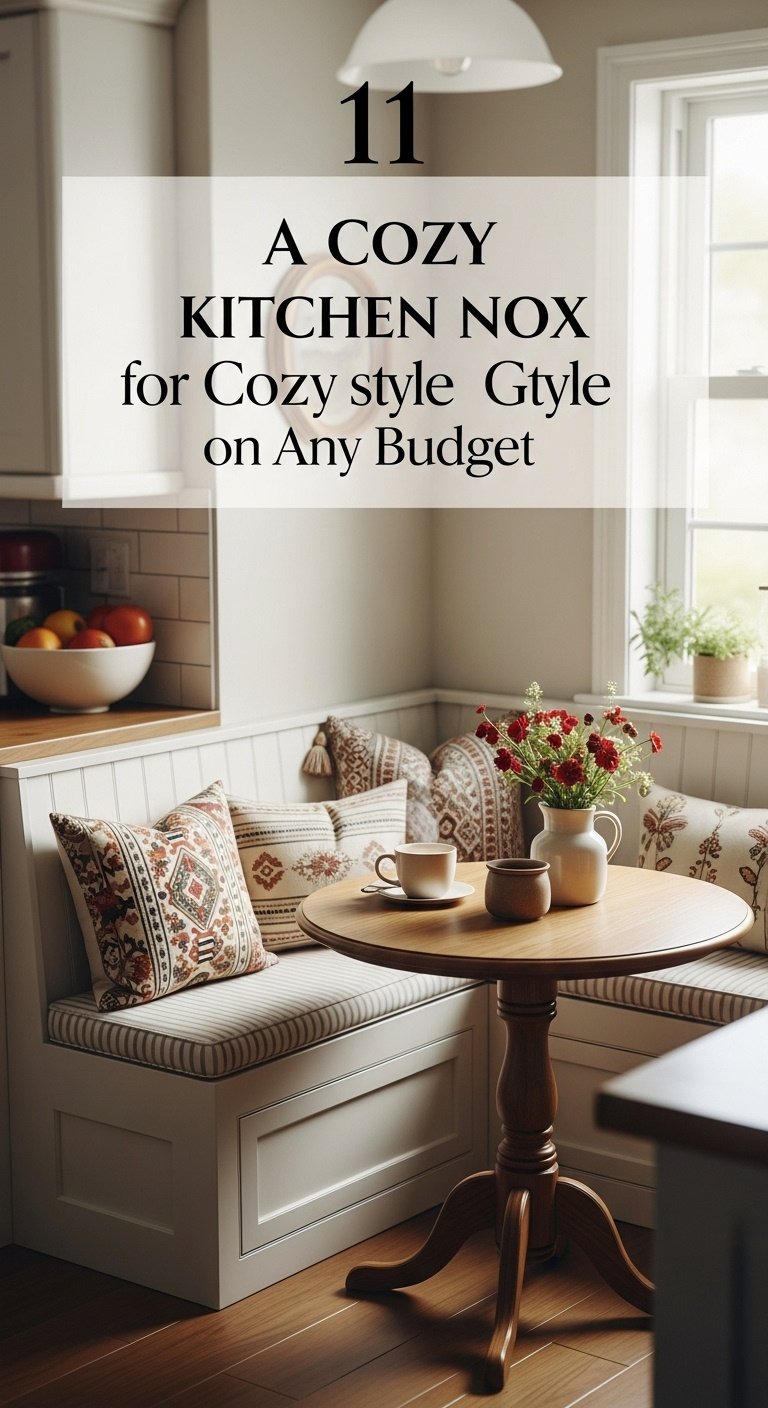
Create your own cozy corner! Pin this dining nook idea.
Key Takeaways: Your Quick Guide to a Warm Kitchen Aesthetic
Feeling overwhelmed? Don’t be! Creating a warm kitchen aesthetic is all about layering. Here are the most important takeaways to remember:
* Focus on Color & Texture: The fastest and most effective way to add warmth is through inviting, earthy paint colors, natural wood accents (even small ones like cutting boards), and soft textiles like a comfortable runner rug. These elements break up hard surfaces and add instant coziness.
* Lighting is Everything: You cannot have a cozy kitchen with harsh, cool lighting. Swap your bulbs for “warm white” versions, install a dimmer switch for your main lights, and add under-cabinet lighting for a soft, ambient glow.
* Small Details, Big Impact: Never underestimate the power of small, affordable changes. Updating cabinet hardware to a warm metallic like brushed brass, displaying personal decor on open shelves, and adding a few green plants can completely change the personality of your kitchen.
* Budget-Friendly Swaps Work: You don’t need a full renovation for a high-end look. High-quality peel-and-stick backsplashes can add texture and pattern for a fraction of the cost of real tile, and butcher block countertops offer a warm, durable alternative to expensive stone.
People Also Ask About Creating a Warm Kitchen
You’ve got questions, and we’ve got answers. Here are some of the most common queries about achieving that coveted warm kitchen aesthetic.
How can I make my kitchen look warmer?
To make a kitchen look warmer, you should introduce elements that engage the senses and feel inviting. Start by painting with warm color palettes like beige, taupe, or soft reds. Then, incorporate natural textures such as wood shelves, a jute rug, or terracotta pots. Finally, layer your lighting with dimmable fixtures and warm-toned bulbs to create an inviting glow in the evenings.
What kitchen style never goes out of style?
While specific trends come and go, a classic, well-designed kitchen that prioritizes quality materials and a functional layout is considered timeless. Styles like Shaker and Farmhouse, which emphasize natural materials and craftsmanship, have incredible staying power. The classic white kitchen is also considered timeless due to its sheer versatility and ability to adapt to changing accent colors and decor.
What is a warm kitchen color?
A warm kitchen color is any hue that has red, orange, or yellow undertones. This includes a vast range of shades, from soft off-whites and creamy beiges to earthy terracottas, warm grays (often called “greige”), soft yellows, and even deep, cozy colors like emerald green or navy blue when they are paired with warm accents like wood and brass.
How can I add warmth to a white or grey kitchen without renovating?
You can easily add warmth to a white or grey kitchen with simple, non-permanent decor swaps. The best methods include introducing natural wood accents through cutting boards, bowls, or floating shelves. Adding a colorful runner rug, swapping out silver cabinet hardware for brushed brass, and placing potted plants and herbs on the windowsill or countertops will also make a significant and immediate difference.
Final Thoughts
Your kitchen should be a reflection of you—a place where you feel comfortable, creative, and happy. It’s so much more than just a room for cooking; it’s the backdrop for daily life. By thoughtfully layering in these elements of warm color, natural texture, and soft light, you can transform any kitchen into the truly inviting heart of your home. Creating a space you love doesn’t have to be a massive, expensive overhaul. It can be a journey of small, joyful changes.
Which of these ideas are you most excited to try first? Let us know in the comments below
